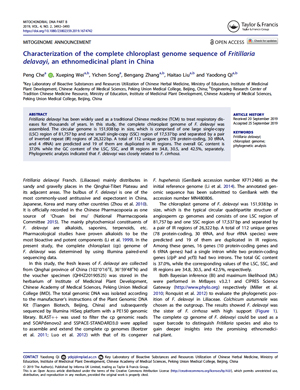NEWS 2019
Characterization of the complete chloroplast genome sequence of Fritillaria delavayi, an ethnomedicinal plant in China
Peng CHE1, Xueping WEI1, 2, Yichen SONG1, Bengang ZHANG1, 2, Haitao LIU1, 2, Yaodong Qi1, 2
MITOCHONDRIAL DNA PART B, 4(2): 3492–3493 (2019)
https://doi.org/10.1080/23802359.2019.1674742
1Key Laboratory of Bioactive Substances and Resources Utilization of Chinese Herbal Medicine, Ministry of Education, Institute of Medicinal Plant Development, Chinese Academy of Medical Sciences, Peking Union Medical College, Beijing, China
2Engineering Research Center of Tradition Chinese Medicine Resource, Ministry of Education, Institute of Medicinal Plant Development, Chinese Academy of Medical Sciences, Peking Union Medical College, Beijing, China
Abstract
Fritillaria delavayi has been widely used as a traditional Chinese medicine (TCM) to treat respiratory diseases for thousands of years. In this study, the complete chloroplast genome of F. delavayi was assembled. The circular genome is 151,938 bp in size, which is comprised of one large single-copy (LSC) region of 81,757 bp and one small single-copy (SSC) region of 17,537 bp and separated by a pair of inverted repeat (IR) regions of 26,322 bp. A total of 112 unique genes (78 protein-coding, 30 tRNA, and 4 rRNA) are predicted and 19 of them are duplicated in IR regions. The overall GC content is 37.0% while the GC content of the LSC, SSC, and IR regions are 34.8, 30.5, and 42.5%, separately. Phylogenetic analysis indicated that F. delavayi was closely related to F. cirrhosa.




